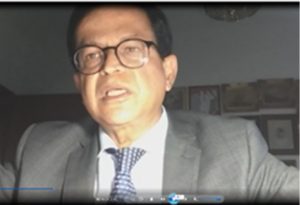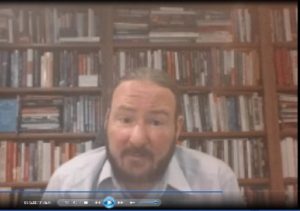High-Level Political Forum on Sustainable DevelopmentReport of the HOPe/Hiroshima Prefectures’ session on the “Special Event of the UN 2021 High-Level Political Forum on Sustainable Development

1 Overview
(1)Date
July 13, 2021 3:00 am~4:30 am [JST]
( July 12, 2021 2:00 pm~3:30 pm [EDT] )
(2)Summary
Hiroshima Prefecture/HOPe participated in the “HLPF Special Event” organized by the United Nations Department of Economic and Social Affairs (DESA), the Division for Sustainable Development Goals (DSDG), and UNITAR. The event consists of total 10 sessions, and HOPe co-hosted one of those sessions.
(3)Theme
Nuclear Disarmament and Our Sustainable Future
2 Results
(1)Number of the online participants: 125 persons
(2)Feedback by the participants: (In total 30 feedbacks)
① Assessment
グラフ①-1024x176.jpg)
② Countries of residence
グラフ②-1024x606.jpg)
(21 countries: Algeria,Australia,Bangladesh,Cameroon,Chile,Cote d’Ivoire,Ethiopia,Fiji,France,the United States,India,Italy,Monaco,Morocco,Nigeria,Pakistan,Poland,Rwanda,Senegal,Sri Lanka,Venezuela)
③ Comments from the online participants
- Excellent session, both presentations and speakers were very good.
- It would have been better to see the inclusion of an interpreter service (French-speaking), since only English-speaking countries are represented.
- I was motivated to counteract nuclear power with concrete and collaborative actions.
- It was full of insights on how to reduce the investment in nuclear weapons and shift them to the education sector.
- I thought that the cost of nuclear weapons should be directed to medical care.
- It was the most relevant and insightful topic for the special event.
3 Contents
(1)Video message by Hidehiko Yuzaki Governor, Hiroshima Prefecture/ President of HOPe
(2)Presentation by Kunihiko Shimada, the Principal Director of HOPe
- Presentation of the projects of HOPe
- Brief Introduction of the Discussion Points (How we can connect the issue of nuclear weapons and SDGs)
- Commonalities between “COVID-19 pandemic” and “issues of nuclear weapons” “Interconnectedness of “issues of nuclear disarmament” and “SDGs” Envisioning a nuclear free world.
Presentation Kunihiko Shimada

(3)Presentations by the Speakers
|
【Mr. Nikhil Seth United Nations Assistant Secretary-General, Executive Director, UNITAR】
|
|
【Dr. Douglas Shaw Nuclear Threat Initiative (NTI) Senior Consultant】
|
|
【Ms. Vanda Proskova Vice-Chair, Prague Vision Institute for Sustainable Security】
|
|
【Mr. Kento Suzuki, Chief Director, Personaliation Project】
|
(4)Free Discussion (Overview)
Can we eliminate nuclear weapons? How?
- The SDGs is also criticized as impossible to achieve. Will we really be able to eradicate poverty and hunger, provide health and well-being to all people, and provide energy by 2030? Pessimism is swirling in the air, but idealism and setting goals are the most important things to start with. The same thought should be applied to the issue of nuclear weapons.
- It is not a question of whether or not we can do it, but whether or not we must achieve it. We need to take that stance.
How we can involve the nuclear-weapon states to achieve the world without nuclear weapons?
- The issues of peace and security, including the issue of nuclear weapons, are actually deeply related to the issues of human rights and the SDGs, but they are not seen as such. We need to break down the barriers. Even at the UN, the Security Council, Geneva and the Disarmament Division are in charge of security issues, so we will be told not to mix up these separate issues. The United Nations also has these barriers. It will be a big challenge to try to move these issues as a series.
- Over the past decade, a trillion dollars have been spent on nuclear weapons. Young people are debating how many student tuition debts can be covered, how many wells can be dug, how many hospitals can be built, etc., with the amount of money spent on nuclear weapons per second worldwide
Regarding nuclear energy issues
- There is the problem of the risk of nuclear materials. It leads to nuclear proliferation. There is also the problem of nuclear waste. Many technologies, including nuclear fusion, may solve the problem and make it possible to manage nuclear materials. On the other hand, it is well known that these are not always manageable and that there are risks
- Especially for poor countries, these are difficult to manage nuclear energy. No one has been able to give a definitive and convincing answer as to whether nuclear energy is “clean and green.”
- Technology is progressing, and so are interpretations of treaties. A double-edged blade. The original purpose of nuclear weapons control was to control technology in order to eliminate instability under deterrent conditions. There are diverse technologies that can disrupt a stable situation. It is necessary to actively manage technologies that bring about a variety of instabilities.
- On the other hand, we are now able to do things that were unthinkable a decade ago, such as monitoring from space, providing knowledge to the public, and using machine learning to monitor nuclear activities and verify nuclear weapons.
The nuclear weapon states say that because they have nuclear weapons, they are able to stabilize deterrence and prevent war. How can we eliminate nuclear weapons while guaranteeing security?
- The issue of COVID-19 drew attention from national security to how to protect personal security, welfare and health. Likewise we should shift our focus from national security to human security.
- Even before 1945, the ethical, deterrent, and strategic aspects of nuclear weapons had been considered by the scientists at Los Alamos. The only way is for all communities to gradually reduce their arsenals, involving youth and industry. This process will be repeated, and the reduction will be gradual
- Even before 1945, the ethical, deterrent, and strategic aspects of nuclear weapons had been considered by the scientists in Los Alamos. The only way is for all communities to gradually reduce their arsenals, involving youth and industry. This process will be repeated, and the reduction will be gradual.
- Fundamentally, there is distrust and scepticism between nuclear weapons states and non-nuclear weapons states, and between states.
It is necessary to expand personal connections and shared awareness of issues beyond national borders. I will encourage more people to recognize social issues as their own concerns through my own initiative, the Personalization Project.
Inquiries about this page
Hiroshima Organization for Global Peace (HOPe)
Street address:10-52, Motomachi, Naka-ku, Hiroshima-shi, Hiroshima-ken, 730-8511
Tel:+81-(0)82-228-2111
Tags associated with this article








![[Report] Hiroshima-ICAN Academy 2021 Special Program [Report] Hiroshima-ICAN Academy 2021 Special Program](https://hiroshimaforpeace.com/en/wp-content/uploads/sites/2/2022/04/thumbnail-150x150.png)


